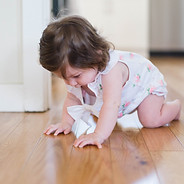
DEVELOPMENTAL
THERAPY
Our children are blocked on a survival level, which means they won’t get to go through new experiences that help them develop. Using the concept of integrating — not inhibiting — the reflex, we work on the level of brain organization to help improve the quality of patient functioning.
A child’s development is fascinating. To watch a child (birth-age 5) progress from developmental milestone to milestone is such a joy. Sometimes though, there can be difficulties in this process due to circumstances we can identify or circumstances that are unknown. Developmental therapy, using primitive reflex integration, can help.
Reflex integration can change lives. The disorganized student may move toward self-organization, the struggling reader may move toward competence, the emotionally challenged may move toward opening up to the world, trusting others, and experiencing wonder and joy. The prognosis and outcome for each child will vary depending on the underlying disorder, the extent to which the sensory and motor systems are challenged, the number of reflexes that are impacted, and the amount of time that can be dedicated to the reflex integration work.
When dysfunctional reflexes are addressed with proper integration techniques, a function can be improved or even restored. Individuals will move closer, step by step, to reach their fullest potential when experiencing reflex integration work.

A reflex:
-
is an automatic motor response
-
responds to a sensory stimulus
-
interacts with the outside environment
-
manages vital internal function
-
is the foundation for emotional regulation
-
is the foundation for cognitive success
.png)
Integrated reflexes:
-
provide protection
-
provide positive growth and development
-
organize the brain
-
create efficient neural pathways
-
have a great emotional impact on interactions in the environment
-
have great behavioral impacts on familiar, novel and threatening situations
